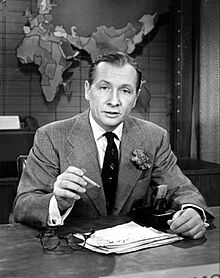John Cameron Swayze facts for kids
Quick facts for kids
John Cameron Swayze
|
|
|---|---|

NBC's Camel News Caravan in 1955
|
|
| Born | April 4, 1906 |
| Died | August 15, 1995 (aged 89) |
| Occupation |
|
| Years active | 1940–1985 |
| Spouse(s) |
Beulah Mae Estes
(m. 1935) |
| Children | 1 son, 1 daughter |
John Cameron Swayze (born April 4, 1906 – died August 15, 1995) was a well-known American news presenter and TV personality. He was famous in the 1940s and 1950s for hosting news shows and appearing on game shows. Later, he became even more famous as a spokesman for products, especially Timex watches.
Contents
Early Life and First Jobs
John Cameron Swayze was born in Wichita, Kansas. His father sold medicines wholesale. John went to school in Atchison, Kansas, and later at Culver Military Academy. He left college early to start working in radio.
Swayze first wanted to be an actor on Broadway. But it became hard to find acting jobs after a big economic downturn in 1929.
Career in News and TV
Starting in Radio
After his acting dreams, Swayze went back to the Midwest. He worked for the Kansas City Journal-Post newspaper as a reporter. He also became their radio editor. He would read news updates for the Kansas City radio station KMBZ right from the newspaper office.
In 1933, he started his own radio show called Stranger Than Fiction. Swayze also worked in sports, writing about and broadcasting football games. He even took part in some of the very first experimental television broadcasts.
By 1940, Swayze was working full-time doing news updates for KMBZ. He often read news stories that were prepared by Walter Cronkite, who later became a very famous news anchor himself.
Moving to National TV
In 1946, Swayze moved to Hollywood. There, NBC hired him to be in charge of news and special events for their Western region.
NBC then moved Swayze to New York City. He suggested a radio quiz show where celebrities would guess who said famous quotes from the news. This show was called Who Said That? It started on radio in 1948 and then moved to television in December 1948. Swayze was a regular panel member on the show. He was even called the "anchorman," which might have been one of the first times that word was used on TV!
In 1948, NBC chose Swayze to host their national political convention coverage. This was the first time a TV network covered such an event for a wide audience.
Becoming a News Anchor
In 1948, NBC created The Camel Newsreel Theatre. This was a short, 10-minute show that used newsreel films of daily events. Swayze narrated these films and often wrote the scripts. This show was an early version of the TV news programs we see today. It was sponsored by R. J. Reynolds Tobacco Company, which made Camel cigarettes.
In February 1949, NBC launched the Camel News Caravan. This was a 15-minute show where Swayze appeared on screen. It was special because it used news stories filmed by NBC, not just old movie newsreels. Swayze would read news from wire services and sometimes interview important people.
He is best remembered for reporting on the Korean War every night. He also had two famous sayings: "Let's go hopscotching the world for headlines" and his sign-off: "That's the story, folks—glad we could get together."
Other famous broadcasters like David Brinkley and Walter Cronkite said Swayze had an amazing memory. He could often recite the news without needing a script or a teleprompter (a device that shows text to a speaker).
By 1955, the sponsorship for the Camel News Caravan changed. Eventually, NBC decided they wanted a different style of news delivery. Swayze's style was seen as too flashy compared to other anchors like Douglas Edwards at CBS. His show's ratings began to drop. In 1956, Swayze was replaced by a new team, Chet Huntley and David Brinkley. Their show, The Huntley-Brinkley Report, soon became the most popular TV newscast in the country.
Other TV Appearances
From 1955 to 1957, Swayze hosted a TV drama series called The Armstrong Circle Theatre. He also hosted the ABC game show Chance for Romance. He was also a substitute host on the popular game show To Tell the Truth.
Famous Product Spokesman
Starting in 1956, John Cameron Swayze became very famous as the commercial spokesman for Timex watches. He was known for their slogan, "It takes a licking and keeps on ticking."
In one famous live commercial, he strapped a Timex watch to the propeller of an outboard motor. He put the motor in a tank of water and turned it on. When he pulled the motor out, the watch was gone! Without missing a beat, he quickly said, "It's probably on the bottom of the tank—still ticking." Swayze often acted like a news reporter in these Timex commercials before saying the famous slogan.
He also appeared in commercials for Studebaker cars and even a Volvo car commercial in the 1970s. In the Volvo ad, he was driven on a muddy racetrack, and the announcer joked about how much "this man can take," linking it to his Timex ads.
Awards
In 1950, John Cameron Swayze received the Alfred I. duPont–Columbia University Award. This award recognizes excellence in broadcast journalism.
Personal Life
John Cameron Swayze married Beulah Mae Estes in 1935. He passed away in Sarasota, Florida, on August 15, 1995.
He was a distant cousin of the famous actor Patrick Swayze and his brother Don Swayze.

